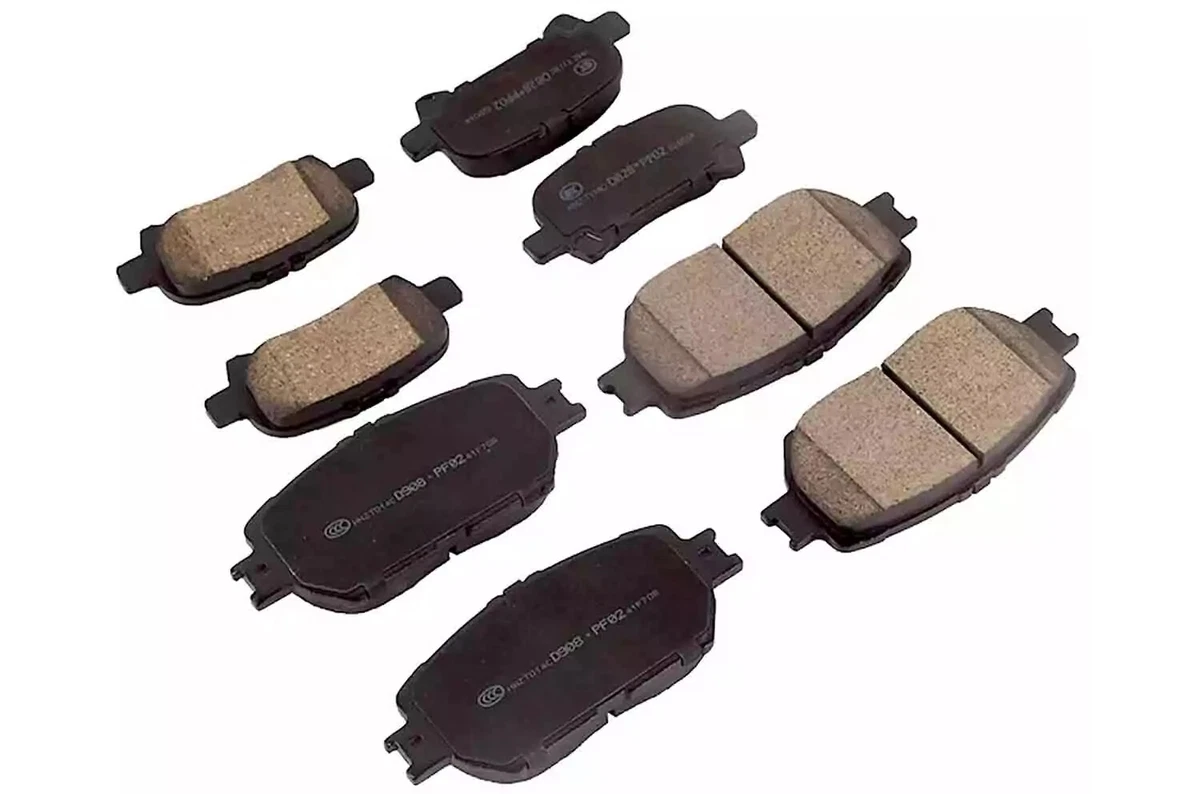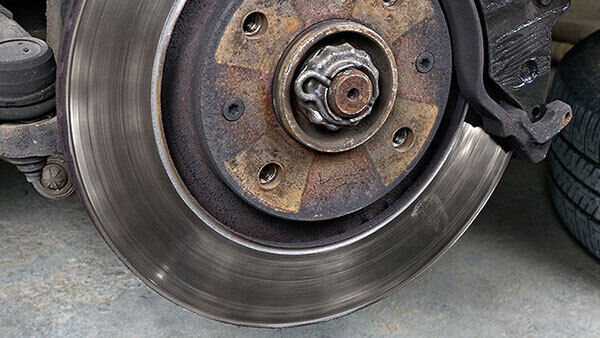Here’s how brake pads work in a modern vehicle’s braking system. Pressing down on the brake pedal pushes incompressible hydraulic brake fluid through the brake lines into a piston inside the brake caliper, forcing the pair of brake pads onto the spinning metal brake rotor. The brake pad creates friction and converts motion into searing heat.
Disc Brakes and Pads vs. Drum Brakes and Shoes

A complete set of Powerstop front disc (top) and rear drum brakes (bottom) for the 1991-1999 Jeep Cherokee and Wrangler.
Disc brakes typically come standard on modern vehicles, but that’s not universal, nor was that always the case. Most cars and trucks used four-wheel drum brakes well into the 1960s. Drum brakes use a wheel cylinder that pushes a pair of brake shoes outward onto the inside of a spinning metal drum. Like brake pads, the shoes create friction when they contact the metal surface. Brake pads work like your fingers catching a spinning frisbee. Brake drums work like pulling a hat tight onto your head.
The front-disc and rear-drum setup became more common in the 1970s. Once reserved for luxury and exotic sports cars, four-wheel disc brakes are commonplace today. Some trucks and economy cars still use a front-disc rear-drum configuration, and a few automakers use a drum parking brake inside the rear disc brake rotor. Front brakes handle the lion's share of braking force. Rear brakes don't work nearly as hard.
We dig deeper into the
differences between drum and disc brakes in our helpful explainer
- opens in new window or tab.
, but you might find it useful to input your information into the
eBay Parts Finder
- opens in new window or tab.
. It allows you to search for brake parts that fit your vehicle.
How long should your brake pads last?
Brake pads are meant to wear out. That's how you know they are doing their job. How long they last and when they retire depends on where they work and how many hours they're on the clock.
Brake pads last anywhere from 30,000 to 70,000 miles. Driving style, vehicle type, and location all influence service life. Stop-and-go urban driving and heavy-duty hauling are tough on brakes, for instance.
This is changing in the modern era. Electric cars and hybrids with regenerative braking systems don't need to be changed as often.
Signs You Need New Brake Pads

This worn-out brake pad should be replaced.
Brake pad wear is something you can hear, see, and smell. Most brake pads have built-in pad wear indicators that produce a loud noise when the pad material hits the safe wear limit. Some use an electronic sensor that triggers a warning light or message. If you hear a loud screeching noise when you hit your brakes, it's time for new brake pads. Don't wait. If the sound turns from a screech to a metal-on-metal grinding noise, it's too late.
If the inside of your car smells like you're heading down a long, steep hill behind a tractor-trailer truck, then your brake pads are overheating. Excessive heat destroys the self-cleaning capability of the brake pad material, resulting in poor braking performance, scored and warped rotors, and uneven brake pad wear. Visible smoke after parking is an extreme example of overheated brake pads.
Visually checking for signs of bad brake pads and brake pad wear is easy. Brake calipers usually have an inspection port. Turn the steering wheel to full lock, turn off the engine, and set the parking brake. Find the hole or open section of the brake caliper and look at the brake pad material. Both sides should show equal wear. It's time for new brake pads if the friction material is unevenly worn or less than the minimum three-millimeter thickness.
For more insight into brake problem signs and symptoms, read our guide explaining
what your brake pads are trying to tell you
- opens in new window or tab.
. Other signs of signs of worn brake pads and that your brake pads need replacing include:
-
Burning smell: An acrid industrial odor from overheated brake pads
-
Deep rumble: A low-pitched grinding noise from metal-to-metal contact
-
Disc wear: Scoring or discoloration of rotor surfaces
-
Dragging: Poor acceleration or fuel economy from a stuck caliper
-
Longer stops: Increased stopping distance
-
Off-center: The vehicle pulls to one side during braking
-
Vibration : A pulsating brake pedal from warped rotors
Brake pad maintenance extends their life
Periodic brake inspection and maintenance can prevent brake pad problems before they start. A good look and cleaning with brake parts cleaner is the best way to detect brake pad, rotor, and caliper wear. A frozen or stuck brake caliper can cause uneven brake pad and rotor wear or outright brake failure from excessive heat. Rust and corrosion from road salt ruins disc brakes in short order. Seasonal brake maintenance is mandatory in the Rust Belt states.
Taking care of your brake pads is easy and can save you money down the road. Check caliper pins, boots, and caliper piston seals. Remove and clean brake pads and hardware. Use high-temperature brake grease on caliper pins and brake pad mating surfaces to stop everything from seizing up in the middle of a record-cold January. Read more about
how to grease brake pads
- opens in new window or tab.
and
why brakes lock up
- opens in new window or tab.
.
Don’t Be Afraid of Replacing Your Brake Pads

A mechanic loads a new brake pad into the brake caliper.
If you're wondering if you can change your brake pads, the answer is yes. Like changing your oil and filter, removing and replacing a set of disc brake pads is automotive maintenance you can easily do yourself.
See our detailed step-by-step
instructions and video about how to change disc brake pads
- opens in new window or tab.
.
Getting to the brake pads themselves can be a challenge. Securing the vehicle on a jack and jack stands, removing the wheels, and freeing the brake caliper and bolts of their rusty grip on the rotors is the first step to brake system inspection, diagnosis, and repair.
How much should you spend on new brake pads?
A new set of replacement brake pads can cost as little as $20. Exotic or high-performance cars can increase that price up to hundreds of dollars.
Brake pads are relatively inexpensive for most applications, but total brake pad replacement costs depend on the condition of the brake system. A new set of brake pads won't fix brake problems if the rotors, calipers, or hydraulic brake lines are worn, damaged, or faulty. Consider a matched set of pads and rotors for time and cost savings. Factor in any brake tools and supplies required to finish the job.
Replace Brake Pads Four Corners at a Time

A complete set of front and rear brake pads for the 2002-2006 Toyota Camry.
Brake pads come in sets of four for a reason. Front brakes wear out before the rear brakes, but replacing both front or rear brake pads and rotors together is the best practice for effective braking and safe driving. Inspect the rotors for rust, scoring, and use a caliper to measure the cross section for minimum thickness.
Now, you can resurface a brake rotor, which we detail in our guide to
brake rotor machining and resurfacing
- opens in new window or tab.
. Resurfacing might save lightly worn rotors, but new pads and rotors at your doorstep and our
brake rotor replacement guide
- opens in new window or tab.
are the best choices for a successful driveway DIY brake job.
Share your feedback
This article is meant to provide general guidance only. Automotive maintenance, repair, upgrade, and installation may depend on vehicle-specifics such as make and model. Always consult your owner's manual, repair guide for specific information for your particular vehicle and consider a licensed auto-care professional's help as well, particularly for advance repairs.













